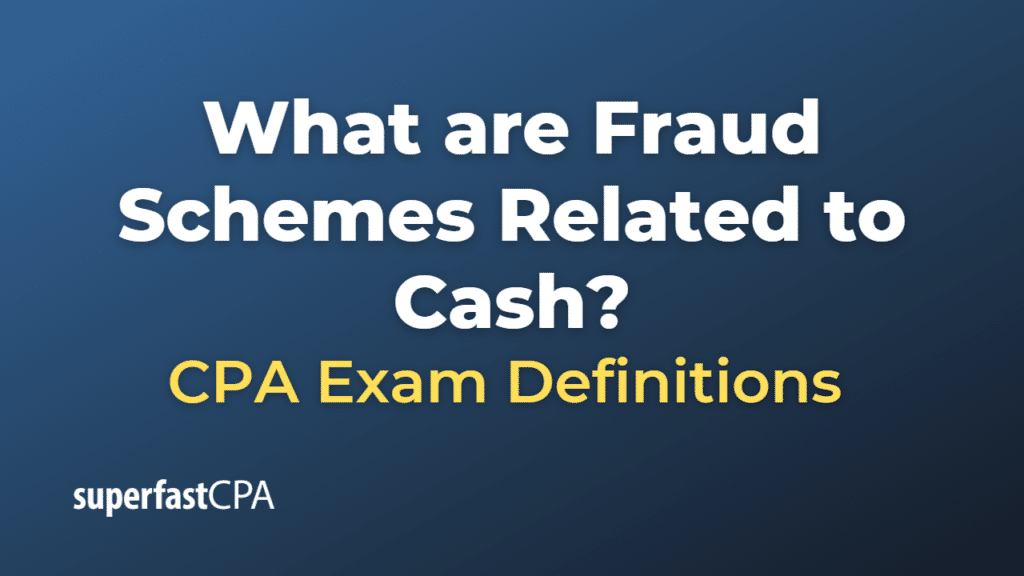Fraud Schemes Related to Cash
Cash fraud schemes are fraudulent activities that involve the theft or misuse of an organization’s cash resources. They often occur when there are weak internal controls. Here are some examples of common cash fraud schemes:
- Skimming: Skimming is the act of taking cash from an organization before it is recorded on the organization’s books and records. This might occur, for example, when an employee takes a portion of the cash sales without recording the full amount of the sale.
- Cash Larceny: Unlike skimming, cash larceny involves stealing cash after it has been recorded on the books. An example would be an employee who has access to cash receipts stealing some of the money.
- Fraudulent Disbursements: This is the most common type of cash fraud. It occurs when an employee uses their position to make a payment for an invalid claim. Fraudulent disbursements can take many forms, including:
- Billing Schemes: In these schemes, an employee generates payments to a fictitious supplier or inflates invoices from a real supplier, often with the funds directed to an account they control.
- Payroll Schemes: An employee might add ghost employees (people who don’t exist or no longer work for the company) to the payroll and then pocket the salaries of these non-existent employees.
- Expense Reimbursement Schemes: In these schemes, employees inflate or submit fictitious expenses and get reimbursed by their employer.
- Check Tampering: This involves an employee forging, altering, or stealing a check.
- Cash Register Disbursement Fraud: This occurs when an employee makes false entries on a cash register to conceal the fraudulent removal of cash. An example would be a retail worker who issues a refund to a nonexistent customer and pockets the cash.
- Money Order and Credit Note Fraud: This is when an employee issues money orders or credit notes without a corresponding transaction, generally for their benefit.
Preventing these schemes typically involves implementing strong internal controls, segregating financial duties, regularly auditing financial activities, and encouraging a strong ethical culture within the organization.
Example of Fraud Schemes Related to Cash
Here are a few examples of cash fraud schemes:
- Skimming: Let’s say a cashier at a clothing store handles cash transactions. This cashier, however, is skimming from the company. When a customer pays in cash, the cashier doesn’t register the sale on the cash register and pockets the money. This way, there’s no record of the transaction, making the theft difficult to detect.
- Cash Larceny: Suppose a receptionist at a dental office is responsible for collecting co-pays and recording them. The receptionist starts stealing a portion of the cash collected each day after recording it in the office’s accounting system. This is an example of cash larceny.
- Fraudulent Disbursements – Billing Scheme: Consider an employee who works in the accounting department of a corporation. This employee creates a fictitious supplier, then generates payments to this supplier. The bank account for the supplier is under the control of the employee, so they can withdraw the money for personal use.
- Fraudulent Disbursements – Payroll Scheme: Imagine a payroll officer at a company who has access to add new employees to the payroll system. The officer adds “ghost” employees to the payroll, then routes their paychecks to a bank account under the officer’s control.
- Fraudulent Disbursements – Expense Reimbursement Scheme: Consider an employee who regularly travels for work. This employee inflates the costs of meals and taxis on their expense reports, or submits receipts for personal expenses claiming they were for business purposes.
- check Tampering: An employee working in the accounts department of a company alters a check made out to a vendor, increasing the amount and cashing the difference.
- Cash Register Disbursement Fraud: A retail worker issues a refund for a nonexistent return. They pocket the refunded money, then adjust the cash register record to make the drawer balance align with the recorded sales.
- Money Order and Credit Note Fraud: A customer service representative at an e-commerce company issues refunds to customers who return items. However, the representative starts issuing credit notes to their own account for items that were never returned.
These examples demonstrate how employees in different roles can exploit opportunities to commit cash fraud. Proper controls, regular audits, and a culture of integrity can help businesses minimize the risk of such fraud.













